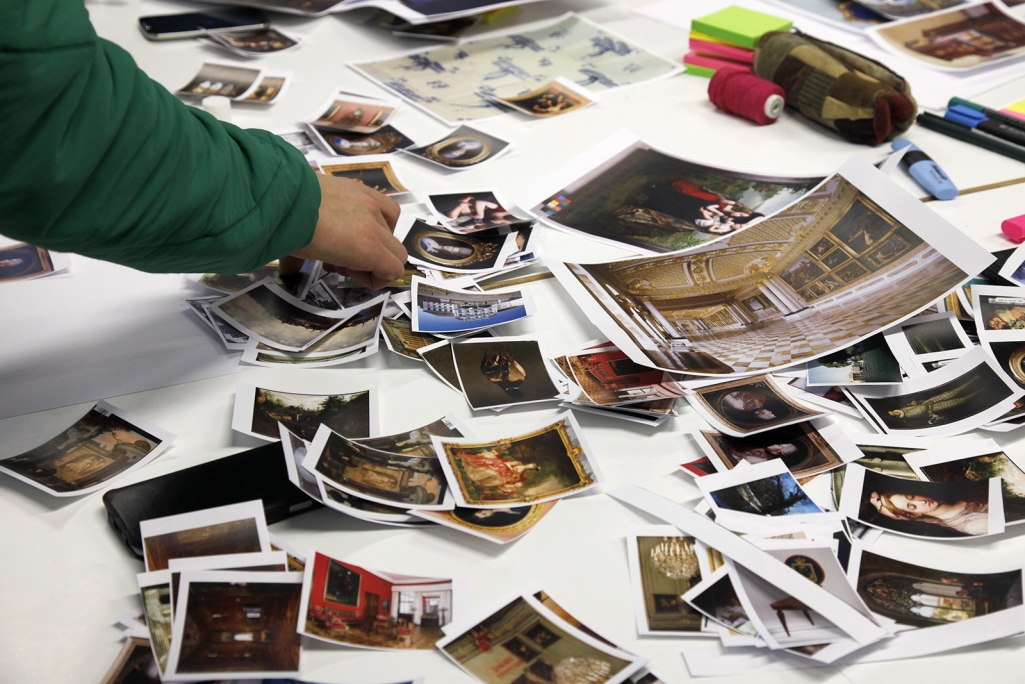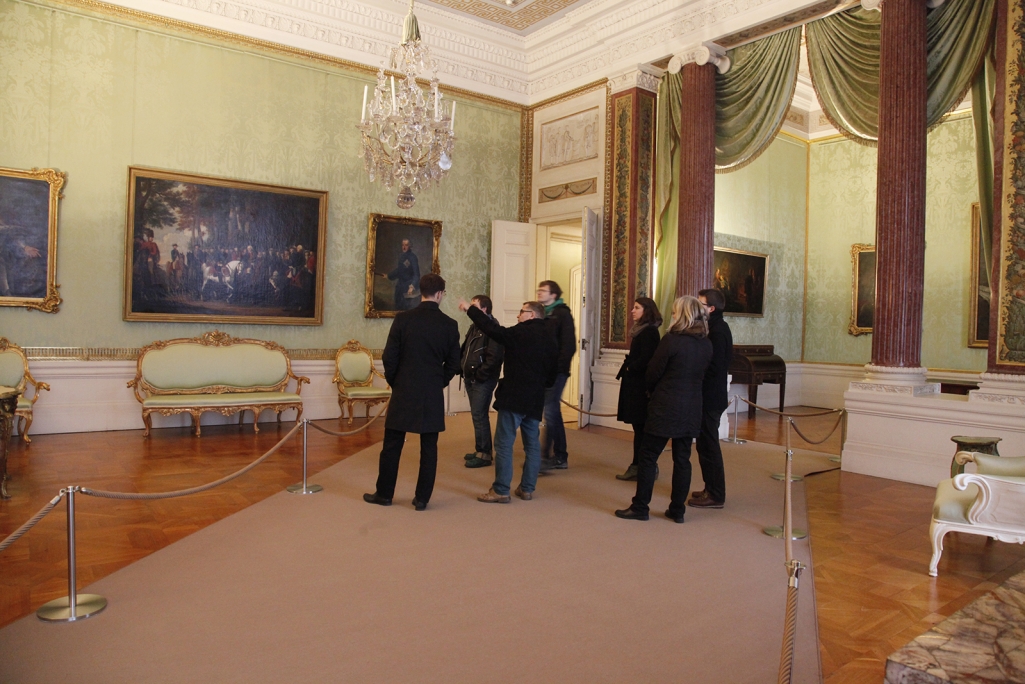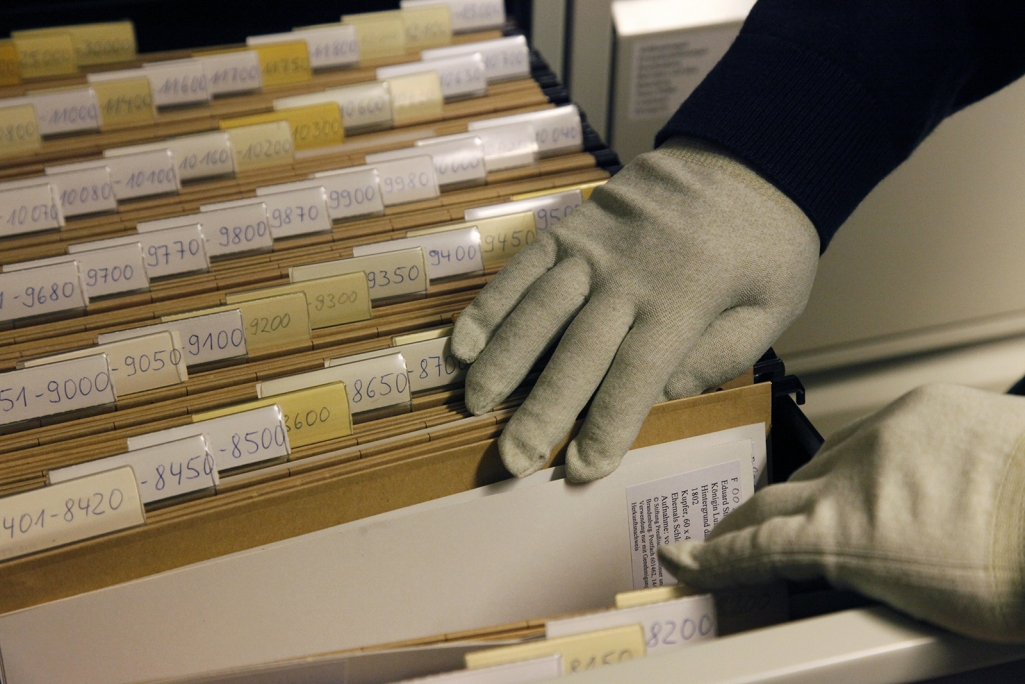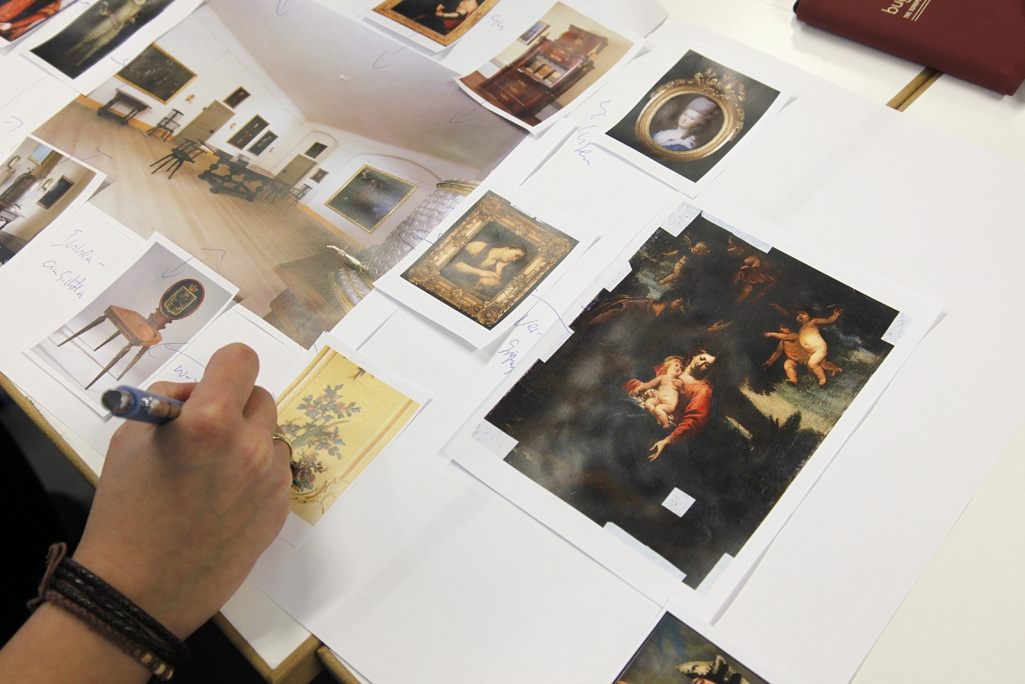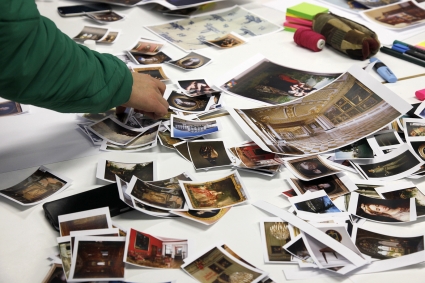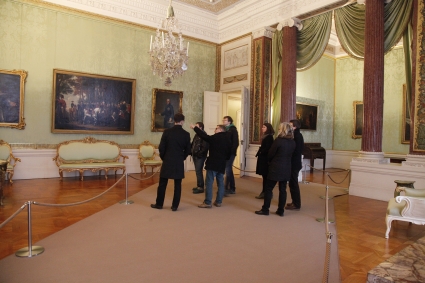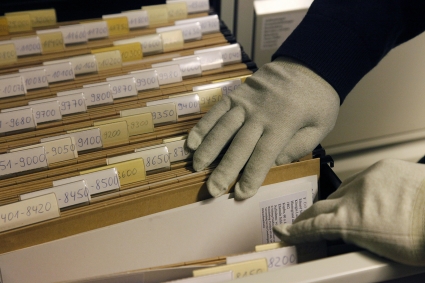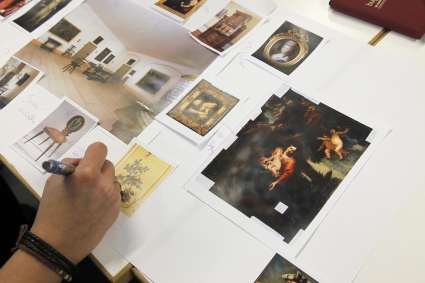The research project »Visualizing Cultural Collections« (Visualisierung kultureller Sammlungen) investigates graphical user interfaces and the potentials inherent to visual exploration of digitized cultural collections. Within the scope of the project, researchers from various fields such as information visualization, interface design, and cultural sciences, will develop and evaluate graphical interfaces that are aimed at enabling interactive examination of cultural objects. The project will liaise closely with cultural collections (e.g. museums, libraries and foundations) as cultural partners, as well as with developers of media databases.
In recent years, numerous projects have been initiated and funded that seek to digitize cultural collections. Archives, museums, libraries and other collecting institutions are now facing the challenge to improve the accessibility of their digitized inventories while also providing new modes of engagement with digitized cultural artifacts.
Digital representation is increasingly seen as a unique perspective on culture that implies a value of its own. While the digital is not set out to replace the physical, it is distinct and has its own advantages. For example, the static arrangement of objects in physical exhibitions can be disseminated in interactive visualizations by means of dynamic layouts that respond to search queries, item selections, and the viewer’s context. So far, visualization technology has not been applied much to cultural collections; however, first prototypes illustrate a multitude of opportunities. For example, visualizations of the semantic structure of a collection along multiple facets could provide entirely new ways to encounter cultural objects.
This project approaches the area of digital cultural heritage by combining technological possibilities with cultural considerations in order to develop visualizations and interfaces that open up new, interesting and useful perspectives on cultural collections. Thereby, novel interaction techniques and representations are designed and evaluated for their suitability for different scenarios. We proceed on the comprehension that visualizations themselves are to be regarded as cultural artifacts that need to be interpreted, designed, and criticized.
With the objective of encouraging innovative ideas in the field of cultural mediation, researchers investigate the potential of novel visualizations of cultural objects with a focus on accessibility and in collaboration with designers and developers. Throughout the project, prototypes are being developed and scrutinized in regards to their applicability as visual exploration tools for digital collections.

Publications
Associated Publications
—
in: KuI (Kultur und Informatik) Cross Media. Busch et al. (Hrsg.) Berlin,
2015
In recent years, access to cultural heritage has been closely connected to digitisation. We argue the case for recognising this digital shift as an opportunity to create interfaces to cultural heritage that are, first of all, more inviting to the public. Secondly, we want to encourage critical approaches towards the representation of cultural production and allow for alternative or even conflicting narratives and interpretations to surface. We present related work, use cases, and concepts for visualisations and interfaces that invite the reconsideration of modes of categorisation, presentation and clustering. Our intent is to develop ways to scrutinise modes of exclusion, carry out critical evaluations and pursue interventional strategies. We discuss the specific potential of visualisation, annotation and dynamic expansion of digital cultural collections. Building on critical approaches in human-computer interaction, visualisation and cultural theories, we explore how the interface could be a means of reflection, critique and inclusion.
Expand
—
in: Konferenzband zur 22. Berliner Veranstaltung der internationalen EVA-Serie: Electronic Media and Visual Arts,
2015
Im Rückgriff auf Ausstellungspraktiken im Museum stellt der Artikel Bezüge zwischen Erkenntnissen aus der Visualisierungsforschung und der Rezeption von Museumssammlungen in einem Ausstellungsdisplay her. Besondere Beachtung finden hierbei Makro- und Mikroperspektiven auf Sammlungen und Darstellungen im (digitalen) Display eines Museums. Visualisierungen können einen offenen und explorativen Zugang zu den digitalisierten Beständen bieten, der eher den Ausstellungs- und Vermittlungsaktivitäten des Museums entspricht oder diese ergänzt. Dabei werden die Potenziale der digitalen Präsentation herausgearbeitet und Anhand von Use Cases aus der Forschung illustriert, welche Ansätze in der facettierten und „kuratierten“ Inszenierung von Sammlungen umgesetzt werden können.
Expand
—
in: International Journal for Digital Art History; No 2,
2016
In this article we present a case study on digital representation of the art historical research and metadata brought together for a scientific collection catalogue by the Prussian Palaces and Gardens Foundation Berlin-Brandenburg. The resulting interface aims at linking the structure and texture of a collection of drawings by Frederick William IV of Prussia (1795–1861) with additional contextual information. The article describes the context of the larger research project and presents the resulting visualization and interaction techniques specifically designed for dynamic exploration along time and subjects.
Expand
—
in: Konferenzband zur DHd 2017 Bern - Digitale Nachhaltigkeit,
2017
Die Entwicklung digitaler Werkzeuge lässt sich als wichtiger Teilbereich in den Digital Humanities identifizieren (Davis und Kräutli 2015; Schnapp et al. 2009). Entsprechende Forschung und Projektarbeit steht dabei komplexen Herausforderungen gegenüber. Nicht nur die Frage nach verfügbaren Daten, methodologischer Fundierung und technologischer Umsetzbarkeit, sondern auch die Frage nach deren langfristigen Verfügbarmachung sind wiederkehrende Themen der letzten Jahre. Eine zentrale Rolle für die Sicherstellung von Qualität und Anwendbarkeit der digitalen Werkzeuge ist die Einbindung von Forscher_innen der jeweiligen geisteswissenschaftlichen Disziplinen im Entwicklungsprozess (Drucker 2013). Gleichzeitig lässt sich die zentrale Bedeutung von Interfacedesign, Nutzungsanleitungen und Benutzerfreundlichkeit als wichtige Faktoren für die Etablierung von digitalen Werkzeugen im Forschungsprozess feststellen (Gibbs und Owens 2012). Doch selbst wenn diese Herausforderungen bewältigt werden und ein digitales Werkzeug (erfolgreich) entwickelt wurde, stellt sich weiterhin die Frage, wie die langfristige Nachnutzung im Sinne einer digitalen Nachhaltigkeit sichergestellt werden kann. Am Beispiel des Entstehungsprozesses einer sammlungsspezifischen Visualisierung und deren Weiterentwicklung zu einem nachnutzbaren Werkzeug werden einige zentrale Aspekte der beeinflussenden Faktoren und Lösungsansätze vorgestellt. Unser Beitrag stellt sich somit der Frage, wie sichergestellt werden kann, dass digitale Tools auch über die Laufzeit von Förderprojekten hinaus (und unabhängig von spezifischen Use-cases) dauerhaft nutzbar und weiterentwickelbar sind.
Expand
—
DHQ: Digital Humanities Quarterly. 11:2,
2017
We present a case study on visualizing a collection of historic drawings along its metadata structure while also allowing for close examination of the artifacts’ texture. With regards to the specific character of cultural heritage at the intersection of research, education, and public interest, the presented visualization environment aims at meeting the requirements of both researchers as well as a broader public. We present the results from a collaborative interdisciplinary research project that involved a cultural heritage foundation, art historians, designers, and computer scientists. The case study examines the potential of visualization when applied to, and developed for, cultural heritage collections. It specifically explores how techniques aimed at visualizing the quantitative structure of a collection can be coupled with a more qualitative mode that allows for detailed examination of the artifacts and their contexts by displaying high-resolution views of digitized cultural objects with detailed art historical research findings. Making use of latest web technologies, the resulting visualization environment allows for dynamic filtering and zooming of a collection of visual resources that are arranged along a contextualized timeline. We share insights from our collaborative design process and the feedback and usage data gathered during the deployment of the resulting prototype as a web application. We end with a discussion of transferability of carefully crafted and collaboratively negotiated visualizations of cultural heritage and raise questions concerning the applicability of our approach to related strands of humanities research.
—
in: Konferenzband zur DHd 2018 Köln - Kritik der digitalen Vernunft,
2018
Das Versprechen hinter Digitalisierungsprojekten in sammelnden Institutionen ist oft die Erweiterung des Zugangs zum kulturellen Erbe, sei es für die Forschung oder im Sinne der Vermittlung. Bei kritischer Betrachtung fast aller Benutzerschnittstellen für Sammlungen scheint es aber an Ansätzen zu fehlen, reichhaltige Informationsräume einladend bereitzustellen. Diese Diskrepanz zwischen Digitalisierung von Sammlungen und ihrer digitalen Verfügbarmachung lässt sich dadurch begründen, dass Kultureinrichtungen selten über die nötige Kapazität verfügen, eigenständig Benutzerschnittstellen zu konzipieren und umzusetzen. Die Zielstellung des dreijährigen Forschungsprojektes Visualisierung kultureller Sammlungen (VIKUS) an der Fachhochschule Potsdam1 war die Erforschung graphischer Benutzerschnittstellen zur explorativen Sichtung von Kulturobjekten. Im Projekt wurden in Kooperation mit Kultur- und Technologiepartnern Erkenntnisse zur visuellen Exploration digitalisierter Sammlungen gewonnen (Glinka et al. 2017a), die Entwicklung nachhaltiger Technologielösungen behandelt (Glinka et al. 2017b) und in experimentellen Settings kritisch-generative Methoden erprobt. Zu letzterem zählt die Übertragung der Forschungsfragen in den Kontext eines interdisziplinären Lehrformats, welches wir in unserem Beitrag diskutieren. Wir gehen insbesondere auf den produktiven Zusammenhang zwischen Kritik und Konzeption von Informationsvisualisierungen ein und zeigen auf, welche Potenziale ein bewusster Bruch mit disziplinären Konventionen und Sehgewohnheiten mit sich bringt.
Expand
—
in: Konferenzband zur DHd 2018 Köln - Kritik der digitalen Vernunft,
2018
Interfaces und Methoden der Informationsvisualisierung dienen insbesondere in Bezug auf abstrakte und komplexe Gegenstände der Unterstützung, Verstärkung und Augmentierung der menschlichen Kognition (Arias-Hernandez et al., 2012). Sammlungen des kulturellen Erbes (Galerien, Bibliotheken, Archive und Museen) sind Paradebeispiele für solche komplexen Gegenstände: sie organisieren und bereiten tausende Objekte auf und stellen diese gemeinsam mit assoziierten Informationen für Forschung und Öffentlichkeit bereit. Viele dieser Sammlungen sind mittlerweile digitalisiert im Netz zugänglich, womit lokale Sammlungs-Interfaces und große Aggregatoren zu Portalen von neuen Informationsräumen werden, in denen Kultur erlebbar und verhandelbar wird.
Ausgangspunkt unseres Vortrags ist eine aktuelle Studie zu Sammlungsinterfaces, die Methoden der Informationsvisualisierung nutzen um kognitive Operationen wie Exploration, Navigation und Analyse auf verschiedenen Ebenen einer Sammlung zu unterstützen. Im Vortrag werden wir einige der durch die Studie gewonnenen Erkenntnisse vertiefen und die Frage ins Zentrum stellen, wie Visualisierungsinterfaces auch jene kognitiven Operationen fördern können, die im kulturwissenschaftlichen Kontext als “kritische” tradiert werden. Analog zu existierenden Definitionen (vgl. Jaeggie & Wesche, 2009; Foucault, 1990; und Butler, 2001) verstehen wir Kritik als jene Form der Kognition, die einen Gegenstand - und das ihn konstituierende Forschungssystem - in seiner Umwelt kontextualisiert und einer Bewertung unterzieht. Dabei bündelt die Operation i) analytisches und exploratives Wissen über Struktur und Dynamik ihres Gegenstands, ii) eine Bewertung im Sinne einer differenzierten Vermessung von Aktualität und Potentialität des Gegenstands, iii) eine Offenlegung und Argumentierung der instrumentalisierten Maßstäben und Normen, sowie oftmals eine iv) Ableitung von Handlungsoptionen zur (Selbst)berichtigung und (Selbst)Steuerung des fokussierten und des fokussierenden Systems.
Mit direktem Bezug auf Fragestellungen des Calls entwickeln wir ein Analyseschema, um dieses Potenzial für Visualisierungssysteme zu kulturellen Sammlungen zu erkunden und diskutieren Designstrategien, um entsprechende Funktionen zu stärken.
—
IEEE Transactions on Visualization and Computer Graphics,
2018
After decades of digitization, large cultural heritage collections have emerged on the web, which contain massive stocks of content from galleries, libraries, archives, and museums. This increase in digital cultural heritage data promises new modes of analysis and increased levels of access for academic scholars and casual users alike. Going beyond the standard representations of search-centric and grid-based interfaces, a multitude of approaches has recently started to enable visual access to cultural collections, and to explore them as complex and comprehensive information spaces by the means of interactive visualizations. In contrast to conventional web interfaces, we witness a widening spectrum of innovative visualization types specially designed for rich collections from the cultural heritage sector. This new class of information visualizations gives rise to a notable diversity of interaction and representation techniques while lending currency and urgency to a discussion about principles such as serendipity, generosity, and criticality in connection with visualization design. With this survey, we review information visualization approaches to digital cultural heritage collections and reflect on the state of the art in techniques and design choices. We contextualize our survey with humanist perspectives on the field and point out opportunities for future research.
Expand


